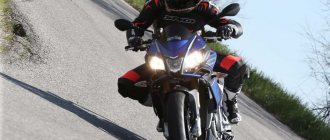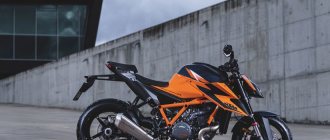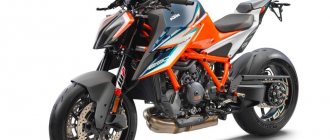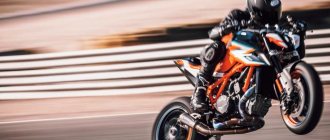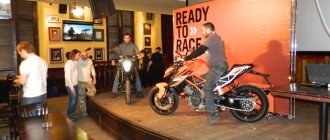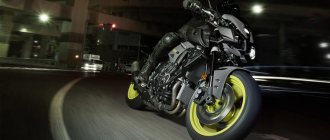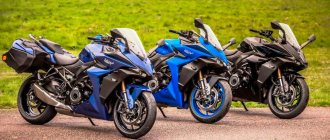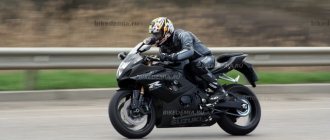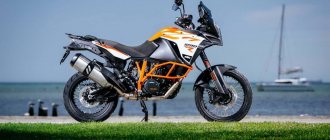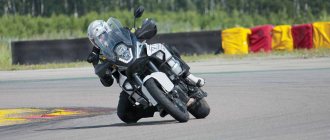The class of over-liter naked bikes combines the best of both worlds. They're built on a superbike chassis, but tuned up and equipped with a daily riding position and manual controls, not to mention the removal of some of the air vent panels. City motorcycles combine speed, comfort and, of course, style.
Comparison of motorcycles SUZUKI GSX-S1000, KTM 1290 SUPER DUKE R, APRILIA TUONO V4 1100 RR
In our last competition, the Aprilia Tuono V4 R ABS won, beating four-cylinder rivals such as the BMW S1000R, MV Augusta Brutale 1090 RR and Kawasaki Z1000. In 2021, Aprilia is not going to give up its superiority, and for this they have launched the Tuono V4 1100 RR ABS. It should also be mentioned that the 2021 Tuono boasts a larger chassis, which makes the already excellent handling even better.
In the two-cylinder motorcycle segment
In the twin-cylinder motorcycle segment, the undisputed leader is the KTM 1290 Super Duke R. In 2015, this model did not have any changes, except for an increase in price. And that's not bad at all. We especially like the fact that this motorcycle is equipped with a high-torque motor, a suspension with long vertical travel that absorbs huge bumps, and a comfortable riding position that will not tire you even on the longest journey. Readers can't wait to compare the Tuono to the orange bike, and that's exactly what we're about to do.
After a long absence from the segment, Suzuki enters the arena with its latest model GSX-S1000 ABS. The GSX series dominated the segment for a decade with its redesigned GSX-R1000 powerplant. The longer stroke engine is mounted in a straight chassis equipped with traction control and ABS.
We held our competition at our usual track, with each bike going through a series of routine tests to help us find out which was superior. Then we compiled all the data into a final table and revealed the winner.
Third place - Suzuki GSX-S1000 ABS
Suzuki GSX-S1000 ABS
A fresh metal body was hung on a liter naked bike, the result was a Suzuki GSX-S1000 ABS. Based on the iconic K5 generation of the Suzuki GSX-S1000 engine, the Model S should attract buyers with its affordable price.
Of course, in today's world, price is often a big motivator, so it's hard to ignore Suzuki's great deals. If you turn on the calculator on your smartphone, you can quickly calculate that a motorcycle from Suzuki costs 30% less than Tuono and 40% less than KTM. But at the same time, you don't get much for the money you pay.
If we talk about electronics, the blue baby is equipped with traction control (three levels, plus complete shutdown) and ABS (always on) , the same way European steel horses are equipped. The bike also has adjustable suspension, inverted forks, digital instrumentation and comparable power-to-weight ratio.
Yes, the in-line single-cylinder Suzuki, which has a smaller displacement, is inferior to 6 “horses” to the 302 cc KTM and 12 “horses” to the powerful Tuono. We see a similar difference in torque: 5% less than the Aprilia and 21% less than the KTM monster. But in the 0-100 km/h test, the Suzuki GSX-S1000 ABS was only a few hundredths of a second behind the V-four, and at 402 meters it was only two tenths behind the two-cylinder bike.
The press says this about this motorcycle:
Perhaps Suzuki should have created the S1000 years ago, like 10 years ago. The engine of the bike is based on the K5, and we all know that it is a great engine.
Smooth, powerful and full of character, at least for a traditional Japanese inline-four, the Suzuki engine undeniably ignites the senses. However, in low gears there was a dip in throttle response, which is not typical for the engine.
Suzuki motorcycles are generally smooth to take off from a standstill and have always been easy to ride. This year we were surprised that the new bike felt a bit choppy. It's not that bad, but cornering this way is very difficult. Compared to the Tuono, the Suzuki doesn't take off as smoothly. But once you get past that initial dip, there's more than enough torque and you're sure to hear those signature GSX traits.
When you step on the gas, you can hear a nice GSX-R-like growl coming from the airbox. But the sound from the exhaust pipe is not so powerful; the sound test showed the most modest result in decibels.
When it comes to power, the Suzuki GSX-S1000 surprises everyone unexpectedly. Although it ranks third in terms of horsepower, you'd never guess it while driving. Energy is supplied linearly. The motorcycle performs best in the mid-rpm range. The R's rev limit is higher than the KTM's. (11,700 rpm versus 9,900 rpm for the orange bike.)
Despite its power shortcomings, the Suzuki has class-leading fuel economy of 15 kilometers per litre. But due to the smallest fuel tank (17 liters), it has a range of a couple of kilometers less than the most voracious Super Duke.
Both the clutch and six-speed transmission work well, but first gear is too long, requiring extra clutch slip. We also noticed that gears need to be shifted carefully and carefully. The bike is not equipped with a slipper clutch, while it is part of the Aprilia's standard equipment and is a great help when downshifting.
The GSX-S was the lightest on the scale (210.5 kg). In addition, it feels like the most compact, but not at all miniature; even a tall driver can sit comfortably in the saddle.
Test riders unanimously found the ergonomics pleasant, and the bike itself extremely comfortable: the motorcycle seat is soft, the legs are in a relaxed position, and the handlebars are located high.
Agile and powerful, the Suzuki is easy to handle and impressive, whether on city streets or on concrete. On tarmac, the chassis absorbs more bumps and bumps than European bikes.
The braking components are not overly specced, so the brakes overall don't feel as sharp or race-like as those found on rivals. But still, according to the results of the braking test, the braking system is very effective. However, we still wish there was an option to turn off ABS completely.
We praised the agile chassis, class-leading fuel economy, and competitive price, but it's hard to ignore its mediocre handling especially on hard surfaces and odd throttle response, which is why the GSX-S relegates to third place.
Advantages of Suzuki GSX-S1000:
· Great motorcycle
· The most economical consumption in its class
· The lightest bike among the test participants
Disadvantages of Suzuki GSX-S1000:
· Throttle valve is “buggy”
· Rigid suspension
· Cannot disable ABS
Second place - KTM 1290 Super Duke R
KTM 1290 Super Duke R
The biggest, best sports bike, equipped with a V-twin, twin-cylinder engine. This is how you can describe the KTM 1290 Super Duke R. The Duke is characterized by a 1.3-liter twin-cylinder engine of the LC8 generation and a thin, tall, three-piece steel chassis. The motorcycle turns heads with its sharp lines and head-turning power.
You will never stop admiring the KTM 1290 Super Duke R:
The punchy, powerful engine makes you thrill, and the comfortable driving position impresses on all levels.
Impressive torque
The KTM 1290 Super Duke R motorcycle has an impressive torque of over 108.5 Nm at 4000 rpm. But after this mark the engine seems to be exhausted. In the range of low and medium speeds you do not feel a lack of thrust, and when it comes to high speeds, the afterburner comes into operation.
When it comes to performance at the top, the KTM 1290 Super Duke R produces as much horsepower as the Suzuki from just 8,000 rpm. The bike boasts 148 “horses” already at 9100 rpm, but the red mark is at 9900 rpm.
But we don’t advise you to try this on the road, because otherwise you risk going to jail. But on the track it’s a completely different matter. Here you can find out how many horses are actually hidden under the hood of the KTM 1290 Super Duke R.
As you pick up the revs, the KTM moves with jerks and impulses (in a good way), as if you were driving a boiling steam locomotive. The exhaust note is throaty, even more so than the Suzuki's sweet howl, but compared to the snarling Aprilia V-twin it's much quieter. Another advantage is that it uses less fuel and has a longer range between fill-ups.
The KTM 1290 Super Duke R accelerates only slightly slower than the 1100 Tuono. The factor that kept the KTM from first place was the tendency for the front wheel to lift in fifth and sixth gears. Sure, the traction control system holds it back, but not as masterfully as Aprilia's class-leading unit.
It turned out that turning the electronic systems on and off is simply crazy: if you turn on the ABS or turn off the traction control or switch the ABS to supermoto mode, and then turn off the engine but do not turn off the ignition, all the systems will turn on again.
The final effect of ABS is another problem; in the test, the motorcycle showed the longest braking distance. With ABS disabled, the brakes were more effective and the bike was only slightly inferior to the Aprilia. Our test drivers entirely prefer to control the brakes themselves, the main advantage of which is the excellent radial master cylinder compared to the outdated GSX-S and Tuono systems.
The gearbox isn't the best, but it's not bad at all. Like the Suzuki, it doesn't have an electronic quickshifter, but it still shifts smoothly.
Otherwise, the KTM 1290 Super Duke R is an excellent motorcycle. Brembo M5 monoblock brakes are the best brakes in the Brembo line. The bike handles street riding very well, it's loud and orange and you can't pass by unnoticed. This is a premium quality product, however, KTM still needs to work on the electronics.
When it comes to comfort, the KTM undeniably impresses, thanks to its tapered midsection, naturally flexing handlebars and relaxed leg position. These ergonomics allow you to literally spend the whole day in the Super Duke saddle.
But it is worth noting that the KTM 1290 Super Duke R vibrates a lot, the vibration is transmitted through both the chassis and the handlebars. Aprilia and even Suzuki are much better in this regard.
Noisy and fast, the Super Duke impresses in many ways, especially its torque. It is also very comfortable, if you are looking for a supermoto style bike, then this orange bike could be a very good option. However, a fairly large price tag and a basic set of electronic systems kept KTM in second place.
Advantages of KTM 1290 Super Duke R:
· Tickles the nerves
· Torque like a turbo diesel.
· Fast, exotic appearance
Disadvantages of KTM 1290 Super Duke R:
· Expensive—40% more expensive than its rival
· Modest set of electronic systems
· Strong engine vibration
One morning my Thunder, the one that sounds like Tuono in Italian and Aprilia in its mother tongue, did not want to start. There was clearly not enough battery charge, and before that I noticed that I heard some strange noise in the scala PACKTALK headphones, similar to interference - interference from the electrical network, a tone that changed with changes in engine speed. I wanted to find the cause myself and eliminate it. Until this moment, I had never had to tinker with the charging system.
I found several useful instructions on the net (tyts, tyts and tyts) that helped identify the problem. At first, the voltage at the battery terminals with the engine running did not rise above 11.5 V. The voltage regulator on almost all bikes, in a simplified form, looks like a three-phase diode rectifier, where the incoming 3 phases of alternating current are rectified into direct current. Based on the diagram, you can use a multimeter to check the integrity of all diodes and their correct operation. For those who do not know how to dial diodes in such a circuit, there is a lot of information on Google and in the instructions, links to which are above. In my case, all the diodes were working, which means the voltage regulator is ok.
But when measuring three incoming phases, the following faults were discovered: the generator produces insufficient linear (phase-to-phase) voltage at the output, there is no insulation resistance and the phases are shorted to the housing. You will have to disassemble the generator cover and remove the stator. On Grom this is quite a labor-intensive task.
1.
2.
To get to all the connecting connectors of the generator and voltage regulator rectifier, I had to disassemble the bike in order on both sides: 1. Seat 2. Tank 3. Side plastic on both sides 4. Lower fairing plastic 5. Drain the oil from the engine and remove the oil tank 6 .Remove the top plastic on the right side 7. Remove the coolant expansion tank 8. Remove the generator cover
In the second picture above, the black arrow indicates the location of the voltage regulator on the right side of the bike. The generator is located on the left side. They are connected by a wire that runs between the two cylinder housings and a brown connector hidden behind the coolant expansion tank. On English-language forums, many owners refer to the frequently occurring so-called “brown connector problem” in which, due to vibration and temperature, the contacts burn out and melt, but I did not have such problems. In any case, this connector comes complete with a new stator.
The stator turned out to be burnt out, a new one is needed. I call the dealer to find out the price (about 500 euros) and wait a month for delivery. Come on, go to the bathhouse, I thought. I somehow got the idea that not a single motorcycle manufacturer produces all the parts at their own facilities, maybe someone else produces the stator for my Thunder. A quick Google search turned up an English company called Electrex World, which makes stators for a variety of motorcycles. For Grom, the price was 3 times cheaper than the original. A week later, a new stator was received and installed, but after 150 km the story repeated itself. After another disassembly, I discovered that the insulation on one coil had broken off and because of this, the stator winding had a short to the housing and there were no other faults. I sent photographs and a description of the defect to Electrex. In the letter, I insisted that this was a chipped piece of insulation, either the result of transportation or a factory defect. A few days later they agreed with my arguments and promised to send a new stator under warranty. In the meantime, I decided not to wait and start repairing this. There are 18 coils in total on the stator, 3 phases with a star connection of the windings, which means 6 series-connected coils for each phase and disconnecting (bypassing) one coil from the circuit will not particularly affect the operation of the stator and the charging system as a whole. Friends doubted my electrical knowledge and dissuaded me from experiments, insisting on waiting for a new stator. This is probably what every biker would do, but we are electromechanical engineers, stubborn people))…
I completely unwinded the copper wire from the damaged coil and cleaned it of pieces of burnt insulating varnish. Then I stripped the ends of the wire and soldered them together, first put the thermal insert on the wire and fixed all the wires in one position for reliability during vibrations. Ideally, I should have applied some insulating varnish, but I couldn't find it in local stores. I secured the stator and all other parts of the bike in place. Final check at engine speeds in the range of 2000 -5000 rpm. showed that the voltage at the battery terminals varied from 13.5 V to 14.8 V, which is what is actually required, judging by the descriptions. A couple of months later I sold the bike and the new owner still rides without problems with the charging system. I received a new stator from England later, it is still on the shelf in its original packaging))) To be honest, after a year of owning this bike, I grew cold to the “Italians”. This, of course, is my personal opinion, but in the end: unreliability, technology inferior to the “Japanese”, high prices for spare parts and long waiting times - I gave up. I should have listened to the advice of knowledgeable people who dissuaded me from buying the Thunder (but I listened to my wife, suddenly, for some reason! And my wife said: “He’s handsome, let’s take it?!”). Problems appeared often because I drive every day. On average there was a week of repairs after three weeks of driving. Finally, after a very positive experience owning a Kawasaki ER-6n, I bought a Kawasaki Versys 1000, ’16 model. While in the process of running-in, I will actually ride it at the TT2016. But I’ll write about this separately... as they say, to be continued.
First place - Aprilia Tuono V4 1100 RR ABS
Aprilia Tuono V4 1100RR ABS
Size matters.
It was under this slogan that the Aprilia factories worked this year, as a result of which the volume of the V-shaped four-cylinder engine that powers the Tuono model increased by 78 cm3. The Tuono 1100 RR ABS not only features larger cylinders, but also various upgrades from the RSV4 superbike that further polish the already sharp axe.
The KTM and Suzuki only shine in certain areas, while the Aprilia has something to show for itself in almost every area. You ask how? The answer lies in the combination of components. how they function, how they provide an unparalleled driving experience.
First of all, it's a charming V-twin four-cylinder engine: smooth, assertive and powerful, the 1100 has all the advantages over the competition. Smooth and vibration-free, the Tuono is great for city driving.
Yes, it's not as punchy as the KTM, but now with a lower final drive (compared to last year's Tuono), the bike takes off with less clutch slip and swamp effect. We praised the performance of the powertrain, with the racing slipper clutch and electronic quickshifter being standout components.
In terms of torque, the four-cylinder motorcycles have similar powerbands despite different reciprocating piston configurations. Although the Tuono is the weakest of the group at the bottom, once the tachometer needle approaches 5000 rpm, the bike becomes fast and powerful, with maximum torque reaching 108.5 Nm at 9500 rpm, beating the GSX-S by 5 .4 Nm, but behind the Super Duke by 16.3 Nm.
However, when it comes to horsepower, the Aprilia has no equal. The bike makes a lot more horsepower than both the orange and blue bikes, from 10,000 rpm all the way to the 12,000 rpm redline.
The Aprilia Tuono V4 1100 RR accelerated to 100 km/h the fastest and also covered the distance of 402 meters the fastest. Here it is worth noting the effectiveness of the electronic start control system (it is turned on at idle by pressing a pair of buttons located on the steering wheel, the electronic system automatically maintains engine rotation at a certain level, ensuring an optimal start).
Even more electronics are associated with the three operating modes of the Aprilia Tuono V4 1100 RR engine (Racing-R, Track-T, Sport-S), allowing you to adjust throttle movement and power. For sporty and street driving, we select the soft S mode, but drivers who prefer a more direct and immediate engine feel will switch to the T mode, and maybe even R. The traction control is adjustable in eight positions, and the ABS— in three, the pilot thus receives a wide range of settings for almost all road conditions.
Sound produced by V4 exhaust pipe
The sound produced by the V4 exhaust pipe is like music, and few production bikes other than the RSV4 superbike can replicate it. Without a doubt, the Aprilia Tuono V4 1100 RR engine sounds much better than its rivals, it feels like you are participating in a Moto Grand Prix. But while the Aprilia's harmonic waves are pleasing to the ear, we can't deny the fact that the bike is the loudest at both idle and speed. In addition, the motorcycle is very thirsty, it consumes 91 gasoline more than its rivals. Fortunately, the largest tank will last for 240 kilometers.
We've always been fans of the Tuono's handling, and the 1100 has found its way into our hearts too. The Aprilia will take you anywhere: through dilapidated city streets, along bumpy canyon roads, and along the flawless asphalt of race tracks. Best of all, you barely have to touch the suspension adjustment knob.
The Aprilia corners well due to its stability, so you feel very confident behind the wheel of the motorcycle. Even if you take turns at high speed, you can be sure that you will lose control.
We really liked the flexibility and functionality of the adjustable ABS system. But the brake system has a weak point - a budget, non-radial, pump-action front brake master cylinder, which negatively affects the initial grip. Still, the Tuono's braking distance was shorter than that of the KTM, which is equipped with a premium braking system.
Apart from the high fuel consumption and the not-so-nice-looking front end, it's hard to find any faults with the Aprilia Tuono V4 1100 RR. From the sense of awe evoked by the V4 to the superb handling that blends sport and comfort, the Aprilia is without a doubt the fastest, most exhilarating and easiest-to-handle naked bike you've ever seen. Unsurprisingly, the Italian motorcycle scored another win in a row in its class.
Advantages of Aprilia Tuono V4 1100 RR:
· Electronic systems that can be customized “to suit you”
Fast, exhilarating, fun V-four engine
· High controllability
Review of Aprilia tuono 1000 r (2007)
It all started when, while on a business trip, I accidentally ended up in a motorcycle dealership. By that time I was riding a 2004 Fire. I was a little over 40 and I was already starting to think about switching from a liter sportbike to something softer in terms of suspension. I loosened the suspension a bit and it got better, but not by much. In short, thoughts about straights were already appearing in my head.
And so I got into the salon and I immediately really liked Millet and Tuono. In my opinion, very beautiful motorcycles. I left Mille with regret, because I didn’t see any point in changing sports for sports, and I just didn’t want to get off Tuono. I went home very impressed and started rummaging around on the Internet and put Fire up for sale. Soon a buyer for Fire appeared and I parted with him (remembering only with kind words). And I buy Tuono, as I wanted, black and gray. Since then, the motorcycle has given me a lot of positive and vivid emotions and I have never regretted my choice.
So the conclusions from the years of operation. High-quality suspension, dense, well-knit, clearly holds the trajectory, is absolutely stable in turns, goes as if on rails, allowing you to carefully use the front brake even when tilted. The ride is noticeably more comfortable than on a sportbike, although of course not an enduro. At the same time, on the advice of friends, I did not touch the factory suspension settings. The street steering wheel seemed more comfortable than the clip-ons, and the bike turned more willingly. Steering is easy and confident. The front brake is enough for the eyes. I'm not used to the rear one and don't use it. When the gas is suddenly opened at speed, the stock damper is activated, the steering wheel jerks for a split second and immediately returns straight.
The element of this motorcycle where it will reveal all its best qualities is a high-speed highway with alternating straights and turns. The bike is not wide, has a short wheelbase and is comfortable in the city. When driving very slowly, you use the clutch to help (this happens automatically when you get used to it). The first speed is a little jerky, harsh, like all B-twins. You get used to it quickly.
I replaced the stock mini wind deflector with a higher one (Aprilia) and it became much better to deal with the wind. Now the comfortable speed is up to 160-180, after 200 you can drive for a short time, but your neck gets tired. My height is 188 cm, if I am shorter it will be easier with the wind. It’s very comfortable to lean on the tank, up to 180 km the wind supports you and you can relax your shoulders on a straight line. Then it will blow away and you have to strain your hands. I accelerated to 245 on the speedometer, then stopped accelerating.
A motorcycle with a dry sump, which makes it possible to ride in the rear with impunity, gets up easily from the gas, but I’m not keen on it. Once again I want to emphasize that, in my opinion, a spendthrift must be liked in appearance. I really have to like it. I had seasons when I traveled very little. But the very fact that there is a spendthrift nearby that you like warms your soul.
